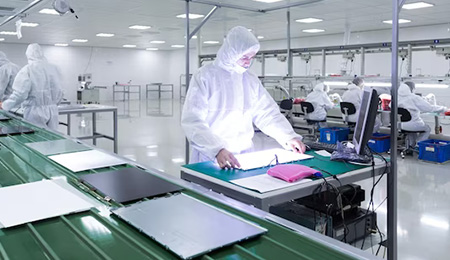
Liquid Crystal Display (LCD) technology has become widely used technique for creating visual displays in devices. At its core, an LCD display consists of liquid crystals sandwiched between two polarized glass plates. By applying an electric current, these crystals can be aligned, which thereby changes the amount of light that passes through. This modulation of light creates the images we see on our screens.
There are different categories of LCD display technologies: TN, which is known for its rapid refresh rate, and IPS, which offers more vibrant colors. More recently VA technology has emerged, striking a balance between TN's quickness and IPS's visual fidelity.
Understanding LCD Panel Types
Liquid Crystal Display (LCD) panels are ubiquitous in modern electronics, fueling everything from smartphones to televisions. While all LCDs share the fundamental principle of using liquid crystals to modulate light, there's a surprising range of panel types available.
Each type employs distinct technologies and structures to achieve different performance characteristics. Some popular categories include TN panels, known for their fast response times but limited viewing angles, and IPS panels, offering superior shade accuracy and wider viewing perspectives. VA panels strike a compromise between performance, with good contrast ratios and decent viewing angles. Understanding these distinctions can help you pick the ideal LCD panel for your specific needs.
Delving into the World of LCD Displays
LCD displays have revolutionized the way we interact with technology. From smartphones and laptops to televisions and monitors, these ubiquitous screens deliver vibrant images and sharp text. But how do they actually work? At their core, LCD displays utilize optoelectronic elements sandwiched between two polarized glass panels. When an electrical current is applied to the liquid crystals, they align themselves, altering the passage of light and creating the pixels that form the image we see.
- These process involves intricate layers of emissive materials that control the flow of light from a backlight source.
- The intensity of the electrical current determines the degree to which the liquid crystals block or allow light to pass through, resulting in varying shades of color and brightness.
- , Moreover , each pixel is composed of three subpixels—red, green, and blue—which blend to produce a wide spectrum of colors.
The sophistication of LCD technology has led to significant advancements in display resolution, color accuracy, and energy efficiency. As our demands for visual clarity and immersive experiences continue to grow, LCD displays remain a cornerstone of modern electronics.
Advantages and Drawbacks of LCD Displays
LCD displays have become the ubiquitous standard in modern electronics, from smartphones to televisions. Their popularity stems from a combination of advantages. While response times have improved significantly, some LCD panels may still exhibit noticeable smearing during fast-paced scenes.
Despite these faults, LCD displays continue to dominate the market due to their cost-effectiveness. Ongoing advancements in LCD technology are constantly striving to address these limitations, making them a viable option for a wide range of applications.

Plasma vs. LED: Which Screen is Right for You?
Choosing the right panel technology can be confusing, especially with so many choices available. LCD, LED, and OLED are three popular models that offer different viewing experiences. LCD screens use liquid crystals to present images, while LED screens utilize light-emitting diodes for crisper colors and contrast. OLED technology takes it a step further by using organic light-emitting diodes that can produce individual dots of pure black.

- LED TVs often offer the top value for money, providing a good mix of features.
- OLED TVs shine with their deep blacks, infinite contrast ratios, and incredibly sharp images.
- LCD TVs are still a popular choice for their low cost.
Ultimately, the best type for you depends on your financial constraints, viewing habits, and desired image quality.
A Look at LCD Display Resolution Evolution
From their initial beginnings, LCD displays have undergone a remarkable transformation. Early models offered relatively low resolutions, often measured in the hundreds of pixels. However, over time, advancements in technology and manufacturing processes have resulted in a dramatic increase in display resolution. , Nowadays, high-definition (HD) and even ultra-high-definition (UHD) displays are commonplace, offering consumers an engaging visual experience. This persistent evolution of LCD display resolution is driven by the needs of users who crave sharper, more detailed images for work.
Achieving LCD Display Brightness and Contrast

When it comes to enjoying your LCD display to its fullest potential, calibrating both brightness and contrast is crucial. Brightness controls the overall intensity of the image, while contrast determines the gap between the lightest and darkest areas.
Start by locating a comfortable brightness level that's legible in your environment without causing eye strain. Tweak the contrast setting to maximize the details in both bright and dark areas. Remember, these controls can be modified on the fly, so take your time to experiment until you achieve a perfect visual experience.
LCD Backlight Types: CCFL vs. LED
When it comes to LCD monitors, the type of backlight used plays a crucial role in determining picture quality, energy efficiency, and overall performance. Two predominant backlight technologies dominate the market: Cold Cathode Fluorescent Lamps (CCFL) and Light Emitting Diodes (LED).
- CCFL backlights utilize fluorescent tubes to emit light when an electric current passes through them. They have been the industry standard for many years, known for their relatively low cost and wide viewing angles. However, CCFL backlights can be bulky, consume more power, and generate radiant energy.
- Light Emitting Diode backlights, on the other hand, are semiconductor devices that emit light when an electric current flows through them. LED backlighting offers several advantages over CCFL, including more compact designs, improved energy efficiency, and higher contrast ratios. LED backlights also produce less heat and can achieve brighter display lumens.
The choice between a CCFL and LED backlight ultimately depends on individual needs and preferences. For those seeking cost-effective options with wide viewing angles, CCFL backlights may be suitable. However, if energy efficiency, brightness, and slim designs are paramount, LED backlights offer a superior choice.
Troubleshooting Common LCD Display Issues

LCD displays can be susceptible to a variety of issues over time. These problems can range from minor annoyances to more serious faults that may require professional repair.
Fortunately, many common LCD display problems can be addressed at home with a few simple troubleshooting steps.
One frequent issue is screen blinking. This could suggest a faulty backlight. Another common problem is ,inaccurate colors, which may be caused by faulty cables.

If you are experiencing any of these issues, here are some steps you can take to troubleshoot your LCD display:

* To begin with, check all connections to make sure they are securely connected.
* Next, try adjusting the brightness on your display.
* Should these steps do not fix the problem, you may need to update the latest graphics card drivers for your computer.
* Finally, if you are still experiencing issues, it is best to contact to a qualified technician for professional repair.
Calibrating Your LCD Monitor for Accurate Colors

Ensuring your LCD monitor displays colors accurately can be vital in various tasks, especially for photographers. A properly calibrated monitor allows you to perceive colors as they truly exist. This can significantly improve your workflow and creations.
- Numerous factors can influence monitor color accuracy, including the monitor's specifications, ambient lighting conditions, and even the individual's view.
- Calibration software can be used to optimize your monitor's settings and achieve a more accurate representation of colors.

Regular calibration is recommended to ensure consistent color accuracy over time. Remember that your monitor's display can change due to various factors, so regular adjustments are essential.
Enhance LCD Screen Refresh Rate for Smoother Motion

Achieving a seamless motion experience on your LCD screen often hinges on the refresh rate. A higher refresh rate implies more pictures are displayed per second, leading to minimal blur and a moreimmersive visual impact.
While some LCDs come with built-in high refresh rates, some may require adjustments to achieve optimal result. To get the mostwith your display, you can explore various settings and configurations.

Here are some tips to improve your LCD screen's refresh rate:
- Examine your monitor's settings menu for a refresh rate option.
- Adjust the refresh rate to the highestsupported value.
- Verify that your graphics card is compatible with the desired refresh rate.
- Refresh your graphics card drivers for the latest version.
By following these guidelines, you can optimize your LCD screen's refresh rate and enjoy a smoother,moreimmersive viewing experience.
Interface Your LCD Display to Various Devices
A modern LCD display often serves as a central hub for several devices. Whether you're streaming entertainment, connecting your LCD to multiple gadgets can improve your workflow. {Thankfully, most modern LCDs offer a variety of connection options. Common ports include HDMI, DisplayPort, VGA, and even USB-C. Determine the specific inputs available on your display and ensure your devices have matching outputs. You may need an adapter or converter to bridge compatibility gaps between different port types.
- {To successfully connect devices, you'll typically need toadjust the input source. This can often be done using a remote control or buttons on the side of the display itself.
- Once connected, your device's output signal will be displayed on the LCD screen. You may need to adjust settings such as resolution and refresh rate for optimal viewing.
Kinds of LCD Connectors and Cables
LCD displays utilize on specialized connectors and cables to transmit image data from the source component to the screen itself. There are several common types of LCD connectors, each with its own features. Some of lcd display the most prevalent include: LVDS, which is commonly used for laptop displays due to its high bandwidth and low power consumption. Another popular type is DVI, often found in desktop monitors, offering a wide range of resolution choices. HDMI is another versatile connector known for its ability to transmit both music and video signals, making it a top choice for modern televisions and multimedia devices. For smaller displays, such as those found in mobile phones, you'll often see connectors like MHL.
Understanding the difference between these types of LCD connectors is crucial when purchasing a new display or peripheral to ensure compatibility.
Designing with LCD Displays: Applications and Considerations
LCD displays provide a versatile platform for a wide range of applications. From home electronics like smartphones and televisions to professional equipment such as medical instruments, LCDs have become ubiquitous. When engineering with LCD displays, several important considerations must be meticulously addressed.
- Resolution and Pixel Density: The resolution and pixel density of an LCD display heavily impact the clarity and sharpness of the displayed image.
- Color Accuracy and Gamut: For applications where color accuracy is paramount, such as in graphic design, choosing an LCD with a broad color gamut is vital.
- Viewing Angle and Contrast Ratio: The viewing angle determines the range of angles from which the display can be viewed without noticeable degradation in image quality. A high contrast ratio enhances the depth and richness of displayed content.
Furthermore, factors like operational cost, pixel switching speed, and environmental resistance should also be meticulously evaluated during the design phase.
Looking ahead to of LCD Display Technology
While QLED technology has been growing in popularity, LCD displays persist as a viable option. Manufacturers are concentrating on {increasing theresolution of LCD panels, alongside improvements in color accuracy.{ The demand for thinner and lighter displays also drives innovation in LCD technology. Moreover, advancements in local dimming methods are helping to deliver deeper blacks, bridging the gap with more advanced panels. As industry trends evolve, LCD technology is poised to remain a significant player for years to come.
Sustainable Practices in LCD Manufacturing
The manufacturing of liquid crystal displays (LCDs) employs a intricate production method. To minimize the environmental impact, manufacturers are increasingly adopting sustainable practices throughout the entire lifecycle of LCDs. This includes reducing energy consumption, disposal hazardous substances responsibly, and encouraging the use of reusable materials.
- Several manufacturers are committing in renewable energy sources to supply their production facilities.
- Strict waste control systems are being implemented to minimize the generation of hazardous byproducts.
- Strategies are underway to engineer LCDs that are more long-lasting, reducing the need for frequent replacements.
Liquid Crystal Displays in Consumer Electronics
LCD screens have revolutionized the world of consumer electronics. Their compact design, excellent contrast ratios, and budget-friendly prices have made them the dominant choice for a wide range of products. From laptops to televisions, LCD displays provide vibrant visuals and clear text, enhancing the user experience.
- The rise of LCD technology is fueled by ongoing research, which frequently leads to enhanced performance and lower costs.
- Moreover, the eco-friendliness of LCD displays makes them a environmentally friendly choice for consumers who are conscious of their environmental effect.


Nevertheless, the future of consumer electronics may see a shift towards QLED displays, which could offer even greater image quality and brighter colors.
LED Screens for Clinical Applications

LCD displays play a crucial/have a vital/serve an essential role in modern medical imaging. Their ability to display/capacity for displaying/skill in presenting high-resolution images with accurate/precise/clear detail is fundamental to/critical for/indispensable in diagnosing and monitoring/treating/managing a wide range of medical conditions/health issues/patient ailments. From X-ray imaging/ultrasonography/radiology, to MRI scans/CT scans/positron emission tomography (PET), LCD displays provide clinicians/offer radiologists/give physicians the visual insights/diagnostic tools/graphical representations necessary for effective/successful/accurate patient care.
- Furthermore/Additionally/Moreover, LCD displays are known for their/recognized for their/appreciated for their reliability/durability/robustness, which is essential/critical/paramount in a healthcare setting/medical environment/clinical facility.
LCD Displays in Automotive Systems
In modern automotive systems, visual interfaces have become indispensable components for enhancing both driver experience. These displays provide drivers with critical data, such as speed, fuel level, and navigation instructions. Moreover, LCD displays in vehicles are increasingly integrated with advanced features, including entertainment systems, rear-view camera displays, and digital instrument panels. The growing demand for intuitive and versatile dashboards has driven the adoption of high-resolution LCD displays in automobiles.
Automotive LCDs are designed to operate reliably under harsh environmental conditions. They withstand temperature fluctuations, vibrations, and exposure to sunlight. Furthermore, advancements in display technology have resulted in improved contrast ratios, viewing angles, and response times. As the automotive industry continues to evolve, LCD displays will play an increasingly critical role in shaping the future of vehicle design and functionality.
Industrial Applications for LCD Screens
Liquid crystal displays are widely used in a wide range of industrial applications. Their capabilities offer high resolution, low power usage, and a wide viewing perspective. These factors make LCDs ideal for use in monitoring systems across various industries.
In the manufacturing sector, LCD screens are utilized for real-time process monitoring. They allow operators to efficiently track and control settings, ensuring optimal production.

,In addition LCDs are utilized in industrial robotics for human-machine communications. These interfaces provide operators with clear information and allow for intuitive manipulation of complex systems.
The use of LCD screens in production settings has led to optimized efficiency, productivity, and safety. Their adaptability makes them a valuable tool for modern industrial operations.